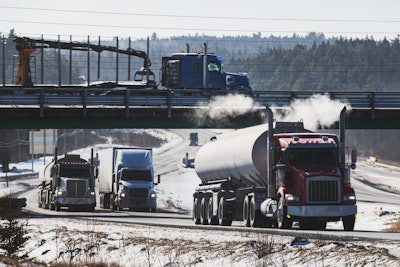
Environmental Protection Agency (EPA) on Friday proposed tighter particulate matter/soot regulations, citing health concerns that the fine particles penetrate deep into the lungs and can result in serious health effects that include asthma attacks, heart attacks and premature death. EPA will accept public comment for 60 days once the proposal is published in the Federal Register.
Of particular air quality concern are residents of disadvantaged areas, which tend to be located along highways, near industrial parks and transportation hubs.
EPA just last month updated emission standards for heavy-duty commercial vehicles for the 2027 model year, tightening tailpipe NOx limits to a level 80%-plus below the current standard – a benchmark truck and engine OEMs nearly universally called "challenging."
Diesel-powered vehicles, vessels, locomotives and equipment account for more that 60% of all nitrogen oxides (NOx) and more than 70% of all fine particulate matter (PM2.5) emissions from U.S. transportation sources, according to the Union of Concerned Scientists. Diesel exhaust particulate matter includes soot and aerosols like ash particulates, metallic abrasion particles, sulfates and silicates.

EPA said in June 2021 it would reconsider the Trump administration’s December 2020 decision to retain the 2012 PM2.5 standards, citing available scientific evidence and technical information indicated that the standards may not be adequate to protect public health and welfare.
“This proposal to deliver stronger health protections against particulate matter is grounded in the best available science, advancing the Biden-Harris Administration’s commitment to scientific integrity and a rigorous scientific process," said EPA Administrator Michael Regan.
The move by EPA would bolster the national ambient air quality standard (NAAQS) for PM2.5, to better protect communities, including those most overburdened by pollution. These particles may be emitted directly from a source, such as construction sites, unpaved roads, fields, smokestacks, or fires; other particles form in the atmosphere as a result of complex reactions of chemicals such as sulfur dioxide and nitrogen oxides, which are pollutants emitted from power plants, industrial facilities and vehicles.
EPA’s proposal will specifically take comment on strengthening the primary annual PM2.5 standard from the current level of 12 micrograms per cubic meter to a level between 9 and 10 micrograms per cubic meter. The agency is also taking comment on the full range included in the Clean Air Scientific Advisory Committee’s (CASAC) latest report (between 8 and 11 micrograms per cubic meter).
"No one should be sickened by the environment they live in, and EPA’s proposal marks the start of changes that will have lasting impacts in communities all over, especially Black and Brown communities that often experience increased PM pollution," said Dr. Doris Browne, former president of the National Medical Association. "Harmful air pollution can have lasting and devastating impacts on people’s health, but by strengthening air quality standards, we can ensure healthier, more sustainable communities across this country.”
Since EPA completed its last review of the PM NAAQS in 2012, the agency said thousands of new scientific studies have demonstrated the dangers of soot exposure. Strengthening the primary annual PM2.5 standard is expected to address disparities and would result in significant public health benefits. EPA estimates that if finalized, a strengthened primary annual PM2.5 standard at a level of 9 micrograms per cubic meter, the lower end of the proposed range, would prevent up to 4,200 premature deaths per year; 270,000 lost workdays per year; and result in as much as $43 billion in net health benefits in 2032.
EPA said it will work with state, local, and Tribal Nations' air agencies to implement the revised primary annual PM2.5 standard when finalized.
Friday’s proposal is the latest in a broad suite of programs under President Biden’s leadership to reduce air pollution in communities, including the proposed Good Neighbor Plan to address smog that affects downwind states; rules to address air pollution from oil and gas operations, including methane pollution; and other critical rules to reduce emissions from power plants and the transportation sector, such as the recently finalized Clean Trucks Rule that slashes smog- and soot-forming pollution from heavy-duty trucks.
Additionally, funding from the President’s Bipartisan Infrastructure Law and the Inflation Reduction Act aimed at cutting pollution from school buses and trucks, port operations, and electricity generation are also expected to reduce soot and other harmful air pollutants.
EPA is also proposing to revise other aspects related to the PM standards – such as monitoring requirements and the Air Quality Index (AQI) – that will help states and Tribal Nations meet the revised standards while making significant strides toward protecting the health of all people, including at-risk populations. The agency is proposing to retain the primary 24-hour PM2.5 standard of 35 micrograms per cubic meter, while taking comment on revising this level to as low as 25 micrograms per cubic meter.











